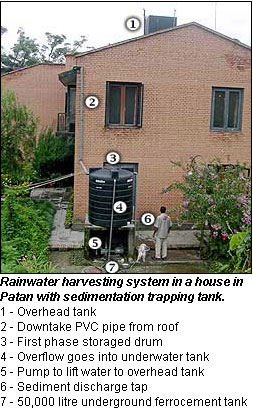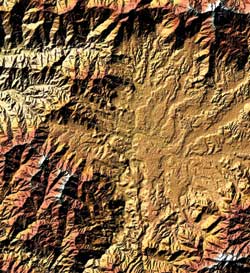 Kathmandu Valley has exceeded the limits of its growth. It is one of very few cities in the world of more than one million people which is not situated on the coast, or along the banks of a big river. We are running out of water, and the Melamchi project is still at least seven years away. What are we going to do till then?
Kathmandu Valley has exceeded the limits of its growth. It is one of very few cities in the world of more than one million people which is not situated on the coast, or along the banks of a big river. We are running out of water, and the Melamchi project is still at least seven years away. What are we going to do till then?
One fact is obvious: there is no point waiting for the government or the municipality to get its act together and provide 24-hour treated water on the mains. Drill a tube well? Sorry. Kathmandu's water table is sinking fast and pumping ground water will not be an option. Migrate to Pokhara? If you can find a job there.
A much cheaper option is to harvest rainwater where it falls: on your roof. It is simple, it is free, it is logical, and it is the only solution. Individual households investing in rain harvesting systems today will have solved the water needs of their own households and the water needs of their children.
The trouble is that 80 percent of the rain in Kathmandu falls between June and September. Nepal has a problem of too much water three months in a year and too little for the rest. We need to store monsoon runoff so that it will last the dry months, and take households till the next rainy season. This means larger tanks, which makes rainwater storage systems more expensive than in other parts of the world where rainfall is more evenly distributed through the year.
But even so, a simple calculation shows that adding a round-the-year rainwater cistern is the only main one-time expense. And its cost is determined by storage capacity. How big should a tank be? A back of the envelope arithmetic for rainwater goes like this:
Suppose you have a 100 sq m roof or terrace area. Kathmandu gets a little more than 1,000 mm of rain every year. If you could collect all that rain, it would fill a 100,000 litre tank. Let's say you can collect 90 percent of what falls: you still have 90,000 litres of rain to play around with.
A 90,000 litre reinforced concrete underground tank would set you back Rs 700,000. And that might be overkill, unless your family is used to soaking in the bathtub every night.
At present, an average conservation-minded middle class household of four people in Kathmandu uses about 250 litres of water a day for cooking, drinking and washing. If we take the dry season in Nepal to be 250 days, then there is a need for only a 250x250=62,500 litre tank. With gutters, PVC pipes, a sedimentation tank the cost of the whole system can come down to Rs 550,000. This may sound like a lot of money, but imagine the peace of mind for the rest of your life (and the lives of your children and grand children) of never having to worry about water.
For households that still get intermittent water supply from the city mains, it will be a good idea not to mix rain water with treated drinking water. So, a separate small tank for treated water can be made (a 2,000 litre outdoor PVC tank would suffice) that feeds water just for kitchen use.
Collecting rainwater where it falls for later use has not been as much a tradition in Nepal as it is in the arid Indian states of Rajasthan and Gujarat. In fact the Rastrapati Bhavan in New Delhi which is the official residence of Indian presidents has a rainwater harvesting system.
Growing urban water shortage in Nepali towns and cities will make this a viable proposition here too. The first known use of a modern rain water harvesting system was in a mission hospital in Pokhara in the 1960s. The US Peace Corps has been active in propagating rain collection models through its volunteers, and lately the government built a large capacity rain tank in Tanahu district. The Finnish-aided Rural Water Supply and Sanitation Project has built 400 two cubic metre rainwater tanks to meet household needs in villages of Gulmi and Palpa districts.
Anil Pokhrel of the Nepal Water for Health (NEWAH) says the beauty of rainwater harvesting is that you don't need multi-million dollar projects. "Unlike big water supply projects like Melamchi, rainwater harvesting is the most decentralised system of getting water. Anyone can collect it."
NEWAH runs an integrated programme for water, health, and sanitation in various parts of the country has for the last five years been helping people in rural communities to tap rainwater for drinking and domestic use. In rural hill areas, most villages are clustered on ridges, where the air is fresher, threat of malaria is minimum, but there is an acute water shortage. NEWAH helps villages situated on ridge-tops to build 24,000 litre ferrocement tanks for harvesting rain.
Nepali water expert Ajay Dixit believes in practicing what he preaches. He harvests rainwater both in his home and office and stores rainwater in a 500 litre tank for the bathroom flush. "It's not an alternative but a complementary supply. By using rainwater we can prevent treated water from becoming sewage every time we flush," he says. Stored water can also be used for meeting other needs like bathing and washing. By way of a gutter and plastic pipes, Dixit also taps rain to feed it underground to recharge groundwater in his locality.
As a means to replenish decreasing groundwater tables, organisations along with NEWAH have begun to rehabilitate old ponds around the Valley to trap rainwater and recharge the water system that provides water to Kathmandu's population.
Existing old ponds in Sankhu, Dharmasthali are being renovated. Ponds in the upper catchment of the Bagmati river in Shivapuri have been built. The Department of Soil and Conservation and Watershed Management (DSCWM) has built conservation ponds to store rainwater in southern Lalitpur while ponds built on hilltops
in this area have also helped stabilise landslides.
Water experts are also looking to India, where rainwater harvesting has been promoted to overcome drinking water scarcity in many cities where the average annual rainfall is 500-700 mm and where many municipalities are now making such systems mandatory in all buildings. "Kathmandu municipality should do the same," says Pokhrel, "offer subsidies on buildings that install rainwater harvesting systems."
For more information:
A Water Harvesting Manual for Urban Areas, and Dying Wisdom published by Centre for Science and Environment, www.cseindia.org
Nepal Water for Health, www.newah.org.np
Nepal Water Conservation Foundation, [email protected]
Frequently Asked Questions
Q: Is rainwater safe to drink?
A: Rainwater collected from roof needs to be have filters like a coarse mesh and a sedimentation tank to prevent debris from flowing into the storage area. Rainwater is free of mineral pollutants found in ground water, but may contain dissolved air pollutants and surface contamination from the roof. These can be minimised by ensuring that the first spell of rain is drained off. Water quality improves with storage as impurities settle and the pathogens die out. Remaining biological contamination can be disinfected by adding bleaching powder (one teaspoon per 200 litres). For drinking purposes, it is still safer to boil rainwater.
Q: What is the best roof surface for rainwater collection?
A: The runoff coefficient for various surfaces determines the quantity and quality of the water that can be used for storage. Tiles and corrugated metal sheets are the most efficient and cleanest rainwater collection surfaces.
Q: What is the best way to stop solid particles from entering the tank?
A: A wire net on the roof drain is the first line of defence. Then, a simple sedimentation loop in the pipe that can be drained periodically, or a first-stage outdoor tank to store water before it overflows into the underground tank will take care of most debris. 
Rainwater collection systems
Can be of various types, capacities and costs: 
1. Rainwater for direct use: This is a simple rooftop catchment with sloping channels feeding directly into an outdoor drum with a tap attachment.
2. Overhead tank storage with overflow: collects rainfall on roof and stores it in an overhead tank that supplies household water supply through gravity. Has an overflow and washout system.
3. Underground tanks: Downtake from roof is taken to an underground storage tank after passing through filters and sedimentation tank.
4. Rainwater storage and groundwater recharge: Water stored for household use and overflow charged into groundwater for withdrawal later.
Does Kathmandu have enough water?  Kathmandu Valley (satellite picture, below) has a catchment of 600 sq km. It gets 1,100 mm of rain annually. There are no snow-fed streams feeding into the Bagmati, so in an average year, 330 million cubic metres of water is available if we can catch it. It would only need 1.5 percent of Kathmandu Valley's total surface area to harvest just six percent of the total rainfall-which would be enough to meet the water needs of all the valley's inhabitants even if they used double of what they use now.
Kathmandu Valley (satellite picture, below) has a catchment of 600 sq km. It gets 1,100 mm of rain annually. There are no snow-fed streams feeding into the Bagmati, so in an average year, 330 million cubic metres of water is available if we can catch it. It would only need 1.5 percent of Kathmandu Valley's total surface area to harvest just six percent of the total rainfall-which would be enough to meet the water needs of all the valley's inhabitants even if they used double of what they use now.


